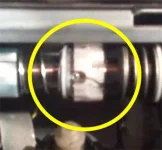- Joined
- Sep 24, 2012
- Messages
- 1,292
- Reaction score
- 645
- Location
- Indianapolis
- Gender
- Male
- Political Leaning
- Other
Issue: I'm trying to fix a broken plastic cylinder. It's about 1" in diameter with a crack down the side. I've used superglue and gorilla glue in the past in similar circumstances, but they don't seem to work, so I wasn't going to waste my time trying that avenue on this part. I was thinking about getting one of those small butane torches and melting it together, but I'm afraid I might melt too much.
Getting a new plastic cylinder is out of the question since it's a piece inside of a printer and the part is not available online. I got the printer for free from one of my clients since it wasn't working. I still haven't figured out how to take it apart to get to the broken part, so I figured I would check for some suggestions before I embark on the 4-5 hour journey (according to some posts I've read online about dismantling this particular model printer).
If I can't fix the part, it's no big deal. But it's a nice printer and I'd hate to toss it without giving it a chance. I figure my worse case scenario is taking a mold of the part and casting a new plastic piece.
Getting a new plastic cylinder is out of the question since it's a piece inside of a printer and the part is not available online. I got the printer for free from one of my clients since it wasn't working. I still haven't figured out how to take it apart to get to the broken part, so I figured I would check for some suggestions before I embark on the 4-5 hour journey (according to some posts I've read online about dismantling this particular model printer).
If I can't fix the part, it's no big deal. But it's a nice printer and I'd hate to toss it without giving it a chance. I figure my worse case scenario is taking a mold of the part and casting a new plastic piece.




